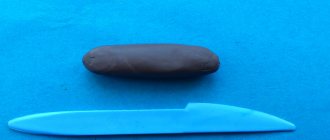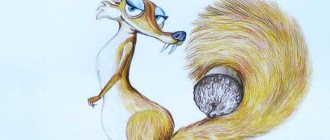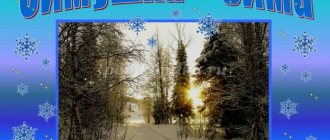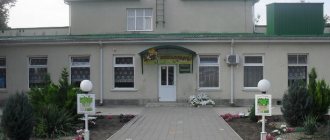Lesson in the senior group. Natural world
Abstract of the integrated organized educational activity “The natural world of our city” for children of senior preschool age
Goal: formation of the foundations of environmental culture. Objectives: • expand children's ideas about the nature of their hometown; to cultivate a kind, merciful, responsible attitude towards nature, to promote the formation in children of the belief that the beauty of nature is priceless, therefore it must be protected. • To foster a sense of pride that in our hometown people take care of and protect corners of nature. • Expand your understanding of the properties of air. • To develop in children a sustainable interest in research activities, curiosity, and observation. • Develop an aesthetic perception of the environment. • Contribute to the development of the ability to listen to each other, complement a friend’s answers, clarify them, and reason. • Improve the ability to reflect your impressions and knowledge about the environment in drawings. Preliminary work: seasonal excursions to the Gubailovo park area; reading works of fiction about nature; observation of objects of living and inanimate nature; work with didactic material “Take care of nature”. Materials and equipment: video presentation “My Krasnogorsk” (slides)
, multimedia installation, game didactic material “Take care of nature”, paintings by artist N. Smirnov depicting landscapes of Krasnogorsk;
audio recording of the cycle “Seasons” by P.I. Tchaikovsky (April “Snowdrop”, March “Song of the Lark”, May “White Nights”)
, audio recording of wind noise, materials and equipment for experimental activities
(cups of water, cocktail straws, plastic bags, paper napkins - for each child)
, music center, materials and equipment for artistic creativity.
Integration of educational areas: “Cognitive direction of development”, “Speech direction of development”, “Social and communicative direction of development”, “Physical direction of development”, “Artistic and aesthetic direction of development”.
Progress of OOD
I. Educator. Guys, today I suggest you talk about the nature around us. Do you agree? Make yourself comfortable. The teacher reads a poem, the reading is accompanied by a video presentation “My Krasnogorsk”. My Krasnogorsk. My Krasnogorsk... I love you. I am proud of you and, glorifying you, I want to sing about you in poetry, have time to say everything about you. I love you for your young age, for your proximity to the center and reliability. Because in our city, we live calmly and peacefully. I love your green outfit, tender look of gardens and parks. I love beautiful ponds, where ducks are of wondrous beauty. I love the cascade of large houses, the coziness of small courtyards. And every time I look with love at the House of Culture “Moscow Region”. My dear town, Beautiful, clean corner I thank you for everything - “Thank you!” - I whisper tenderly... (V. Arsentieva “My Krasnogorsk.”) Educator. What city was the poem talking about? (Children's answers.) Educator. What does the author of this poem admire? (Children's answers.) Educator. Krasnogorsk is an unusually beautiful city, located in the floodplain of the Moscow River, in a forest park protective belt. The surroundings of Krasnogorsk have their own unique natural beauty. What makes up the natural world of our city? (Children's answers.) Educator. The nature of the city is important in the life of every person: after all, in addition to beauty and a wonderful mood, it gives a person something without which it is impossible to live. And what exactly, your answers to my riddles . Well, which one of you will answer: It’s not a fire, but it burns painfully, It’s not a lantern, but it shines brightly, And it’s not a baker, but it bakes. (Sun.) Educator. Can a person live without sunlight and warmth? Why? (Children's answers)
.
Finger gymnastics “Bright Sun” The bright sun was shining in the sky, warming us with its rays. (We raise our palms above our heads, spreading all our fingers like rays, and make rotational movements with our hands.)
The clouds ran quickly across the sky, The rays were stuck in the clouds for a long time.
(We interlock our fingers and perform rolling movements with clasped hands.)
But a mighty wind appeared and dispersed all the dark clouds.
(We raise our hands up and make wave-like movements left and right.)
The sun is shining in the sky again, the hot rays warm us.
(We raise our hands up again and extend our “ray” fingers.) II. Educator. The next riddle: It passes through us into the chest and goes back. He is invisible, and yet we cannot live without him. (Air.) Educator. Air surrounds our Earth. People, animals and plants breathe air. Educator. Guys, do you see air? (Children's answers.) Educator. I also don’t see air, but I know that it is always around us. Nobody sees air, so it is called “invisibility”. Do we see the objects around us through the air? Children. We see through the air, the air is transparent. Educator. That's right, the first property of air is transparency. We cannot see air, but we can feel it. Do you want to test this assumption, feel the air? Then let's play with the air. The first game is the “Wave your palm in the face” experiment . (Children do the exercise.) Educator. What do you feel? (We feel the air moving.) Educator. We can not only feel the air, but also catch it. Want to try? Then take a plastic bag and fill it with air. What do you see? Children. The bag became convex, hard, and elastic. Educator. Why did the bag become elastic? (Children's answers.) Educator. Therefore, the air is elastic. This is another property of air – elasticity. What color is the air? (Colorless.) Educator. Breathe in with your mouth. Try it, what does the air taste like? (Tasteless.) Educator. Inhale air through your nose. What does it smell like? (Without smell)
.
Educator. But the air can carry different odors. When do you think this happens? (Blooming plants, the smell of perfume, the smell of fresh baked goods, etc.)
Clean air has no color, smell, or taste.
Do you think air can be heard? (Children's answers.)
When can you hear it?
(The wind blows.) Educator. Air is constantly moving. Air movement is wind. Let's listen to how the wind blows. (Recording wind noise.) Educator. Wind is the movement of air. Air has the ability to move objects. Whether this is true or not, we will find out with the help of the following experiment. Please take a napkin from the table, a napkin on the table, blow on it. What happened to the napkin? (Children's answers.) Educator. Now we'll play. Breathing exercise “The wind is blowing, blowing...” . (Children pronounce the sound s-s-s at different tempos, with different voice strengths.) Educator. Guys, is there air inside us? (Children's answers.) Educator. Let's check. Please come to the tables and take cocktail straws and glasses of water. Dip a cocktail stick into the water and blow into it. What's happening? (Children's answers.) Educator. We breathe through our nose. The air enters the nose, warms up there and passes through the larynx into our lungs. Air passes through the lungs and comes out again. Educator. Can we live without air? What kind of air does every living thing need? Why? (Children's answers.) Educator. Well done! And one more riddle : They drink me, They pour water on me. Everyone needs me. Who is she? (Water.) Educator. Where can we find water? (Children's answers.) Educator. What else do we consider nature? (Plants, animals, birds, insects, fish, etc.) Educator. The natural world is diverse and unique. Man lives in nature, his life depends on nature. What do you guys think, does the beauty of nature depend on humans? (Children's answers: people plant forests, protect animals, feed birds, clean water bodies, etc.) III. There is a knock on the door, Hedgehog appears, who wants to find out what else the guys know about the nature of Krasnogorsk. Dunno brought as a gift paintings by the artist N. Smirnov depicting landscapes of Krasnogorsk. (Music from the cycle “Seasons” by P.I. Tchaikovsky sounds.)
Hedgehog.
Guys, did you recognize what is shown in the pictures? (The park, which is located next to the kindergarten, ponds.)
Hedgehog.
How are these landscapes different? (Nature is depicted in different seasons.)
Hedgehog.
What do all these paintings have in common? (The Gubailovo district park is shown.)
Hedgehog.
Why do you think this is a park? (There are places designated for rest, paths, benches, lanterns.)
The hedgehog tells the children that he knows that the children went to the park to the ponds on an excursion and wants to check whether the children were attentive during the excursion and what they remembered.
Hedgehog. Asks questions: who was in the park? What did you see there? What grows in the park? What animals and birds live in the park? (Children's answers.)
Hedgehog.
Well done! And now - a moment of physical education. Physical education We walk together in the park, We don’t rush, we don’t lag behind. Here we go out onto the meadow, (Walking in place.)
A thousand flowers around!
(Stretching - arms to the sides.)
Here is chamomile, cornflower, Lungwort, porridge, clover.
The carpet is spread out both to the right and to the left. (Bend over and touch the left foot with your right hand, then vice versa - the right foot with your left hand.)
The arms were extended to the sky, The spine was stretched.
(Stretching - arms up.)
We all had time to rest and sat down again.
(Children sit down.)
The hedgehog asks the children to guess which trees they encountered along the way of their walk in the park.
Hedgehog. You left the kindergarten, walked along the sidewalk, crossed the road at the pedestrian crossing, entered the park and was the first to see this tree. I ask a riddle , if the answer is correct, then the answer picture will appear on the screen. No one is scared, but she is trembling all over. (Aspen.)
We walked further and met: We’ll always find her in the forest. Let’s go for a walk and we’ll meet her. She stands tall, straight, her trunk is made of resin, her needles are only at the top.
(Pine.)
And between the two ponds grew a beautiful, mighty tree: I climbed out of a tiny barrel, put down some roots and grew.
I have become tall and powerful, I am not afraid of thunderstorms or clouds. I feed pigs and squirrels - It’s okay that my fruit is small. (Oak.)
Hedgehog.
What other trees and shrubs did you find in the park? (Birch, rowan, maple, elderberry - slide show.)
The hedgehog reports that such forests, which consist of different trees, are called mixed, and asks the children to remember the word.
Hedgehog. In a mixed forest or park, shrubs grow under the trees, and even lower on the ground there are grasses, small berry bushes, and mushrooms. (Slide show.)
Hedgehog.
In the thicket of the forest, far from the paths, He stands among the aspen trees. There is a hat, but no coat. Guess who it is? (Boletus.)
Along the forest paths there are many white legs.
In multi-colored hats, noticeable from afar, collect, don’t hesitate - this is... (Russula.)
Near the forest on the edge, Decorating the dark forest, It grew motley, like parsley, Poisonous….
(Fly agaric.)
In the clearing near the path Beautiful peas.
Whoever passes by puts everything in his mouth. (Strawberries.)
Hedgehog.
Well done boys! What decorates our park? (Ponds)
.
Hedgehog. If trees, shrubs, grasses, people are reflected in the water, then what do the ponds look like? (On the mirror.)
Hedgehog.
Who lives in the water? Who hatches the chicks in the reeds? (Ducks.
)
What birds did you see and hear in the park? (Children's answers.) Educator. Guys, I see that Hedgehog. I'm happy with your answers. You have been to our ponds in the park, you have seen and remembered a lot there. What do you guys think, does the beauty of nature depend on humans? (People plant forests, protect animals, feed birds, clean rivers, install purification facilities, etc.)
.
Educator. Does man always help nature? Can man destroy nature? (Pollutes water bodies, cuts down trees, traps animals, etc.)
.
Guys, why do you think we need to protect nature? (Children's answers.) Educator. Forests and parks need to be protected and appreciated; they are beautiful at all times of the year. Anyone who feels the beauty of nature and protects it is filled with good, kind feelings. Poets write poems, artists, fascinated by beauty, paint pictures. IV. Hedgehog invites the children to formulate rules for nature conservation and select pictures - signs “Rules of behavior in nature.” A didactic game “Take care of living things!” is being held. Children name the rules, choose a picture: 1. In nature, remember what they see. 2. Walk along the paths. 3. Do not break branches of trees and bushes. 4. Do not trample grass and flowers. 5. Do not shout in the park, forest, or play loud music. 6. Don't catch insects. 7. Don’t destroy birds’ nests. 8. Do not destroy mycelium. 9. Do not catch fry or frogs. 10. Do not break cobwebs. 11. Do not light fires. 12. Do not destroy anthills. 13. Do not wash your bicycle in ponds. 14. Do not pick aquatic flowers. The teacher offers to express their impressions of meeting the Hedgehog, memories of walks to ponds, to the park in their drawings. During the drawing process, individual work is carried out to clarify the concept and execute the work. Drawing is accompanied by musical accompaniment (P.I. Tchaikovsky, cycle “The Seasons”)
.
As the work progresses, the children exhibit their drawings and place them on the exhibition stand. Educator. We are lucky, we were born here, We are lucky, we live here. The infusion of flowers is thick and strong, We drink our Krasnogorsk air! Children give their drawings to Hedgehog.
The hedgehog thanks the children and gives them gifts from the park
(cones, twigs, fruits, leaves)
for crafts.
We recommend watching:
Summary of educational activities in the senior group “Journey to a Fairy Tale” Summary of a mathematics lesson for children of the senior orthopedic group Summary of educational and gaming activities in the senior group in the section of the “Childhood” program Synopsis of educational activities for the perception of music in the senior group of kindergarten
Similar articles:
Lesson in the senior group of kindergarten on the topic of February 23
Lesson notes for children of senior preschool age. Topic: Invisible air
Summary of organized educational activities for children of the senior group
Notes for mathematics classes in the senior group
Lesson summary on the topic “Reserve” in the senior group






